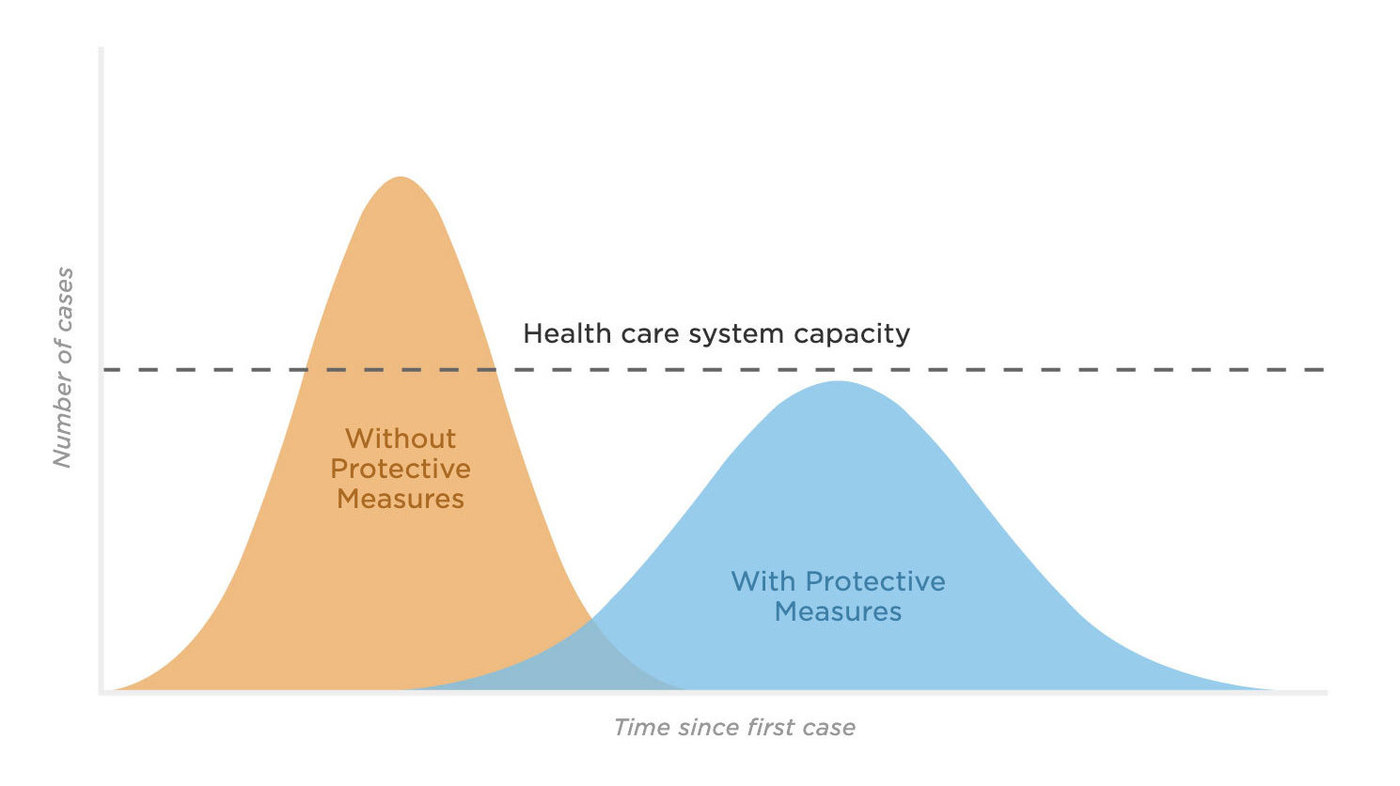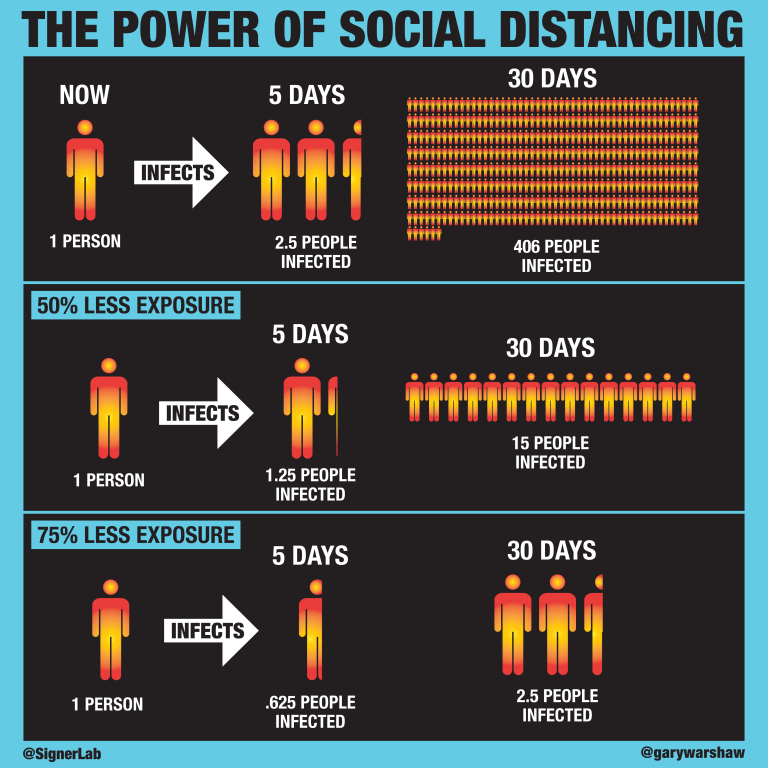Social distancing: how does it work?
Published Mar 24, 2020 • Updated Mar 25, 2020 • By Pauline Heyries
Since the appearance of SARS-Cov2, the virus that causes COVID-19, social distancing measures have been put in place to avoid transmission and stop the spread of the coronavirus. How does an epidemic spread? What is the purpose of containment measures? We tell you everything and encourage you to stay home!

What is an epidemic?
An epidemic is the outbreak and spread of a contagious infectious disease that strikes a large number of people at the same time and in the same place.
Today, the word "epidemic" extends to phenomena that are not necessarily infectious. This is the case, for example, when we speak of the "obesity epidemic".
According to the World Health Organization (WHO), a pandemic is an epidemic that affects a large number of people in a very large geographical area.
Since March 11, 2020, COVID-19 is considered a pandemic because it affects 155 countries (out of 198 recognized by the UN). Calling the COVID-19 epidemic a pandemic does not mean that the virus has become more deadly, it is simply a recognition of its global spread.
What are the mechanisms for the spread of an epidemic?
The spread of an infectious agent within a population is a dynamic phenomenon: the number of healthy and sick individuals evolves over time depending on the amount of contact between the two groups, allowing the agent to pass from an infected individual to a healthy non-immune individual.
The general transmission mechanism of an epidemic is made up of three elements:
- The pathogenic/infectious agent
- The vector
- The environment.
The vector is the living organism that transmits the pathogen/infective agent from one individual to another in its environment.
It is possible to monitor and compare epidemiological trends between cities, regions, countries or continents over time thanks to the epidemic threshold. The epidemic threshold is defined as the critical number or density of susceptible hosts required for an epidemic to occur. When the epidemic threshold is exceeded, preventive and precautionary measures may be adopted or requested by the health authorities.
If you’d like to learn more about the spread mechanism of the COVID-19 epidemic we invite you to read our article: “Coronavirus: What do you need to know?”
What are the strategies used to contain an epidemic?
In the face of an epidemic, different strategies are used to decrease contamination among the population:
- At the individual level, we can reduce the transmission of the virus by implementing barrier gestures adapted to the ways in which the virus is spread. In the case of COVID-19, the main barrier gestures are: coughing into your elbow, keeping a distance of three feet from others, using single-use tissues, etc.
- At the collective level, social distancing reduces the likelihood of contact between infected and uninfected people, thereby reducing disease transmission, morbidity (the impact of a disease on health) and mortality (the number of deaths). Social distancing is particularly effective when the infection is transmitted through respiratory droplets (as in the case of coronavirus) or direct or indirect physical contact.
Conversly, social distancing is less effective in cases where the infection is transmitted primarily through contaminated food or water or by vectors such as mosquitoes.
In the case of the COVID-19 epidemic, why does social distancing play such an important role?
The coronavirus is transmitted through respiratory droplets, so any close contact (unwashed hands, contact within three feet) with a sick person carries a risk of contamination. Furthermore, coronaviruses seem to survive for several hours (8 to 12 hours) in the outside environment on inert surfaces (door handles, tables, elevator buttons, etc.).
For the epidemic to regress, it is necessary to reduce exposure by adopting social distancing measures. This method has already proved successful during the "Spanish" flu of 1918, which claimed more victims than the First World War.
Epidemiologists fear that an "explosion" of contaminations will generate more cases than the health system can handle; in this situation, patients could die due to the lack of care because of the lack of available beds. Bearing in mind that COVID-19 is generally benign, especially in children and young adults, it can also be serious: 1 in 5 patients needs to be hospitalized. It is therefore essential to respect social distancing measures if we want to stop the spread of the virus.

In addition, a team of INSERM (the French National Institute of Health and Medical Research) epidemiologists published a study on March 14th that indicated that eight weeks of school closures and 25% home-working would be enough to delay the epidemic's peak by two months and reduce the number of cases by 40% at the height of the epidemic.
Why is it important to comply with containment measures even if you have no symptoms?
COVID-19 can manifest itself in very different ways from one individual to another. The illness can resemble a seasonal cold or flu (cough, fever, runny nose) as well as a severe respiratory infection like pneumonia or SARS (Severe Acute Respiratory Syndrome). But it can also be asymptomatic (presence of the virus in the body without symptoms or clinical signs of infection). These asymptomatic individuals are called healthy carriers. Even if they do not have symptoms, healthy carriers remain contagious and can spread the disease to others.
With or without symptoms, a person contaminated with COVID-19 can transmit the pathogen to an average of 2 or 3 people. In addition, the time between infection and the onset of symptoms (incubation period) is 3 to 5 days in most cases, but can be as long as 14 days. This means that an infected person can transmit the disease up to 2 weeks before the onset of symptoms. Under these conditions, it is understandable why it is important to comply with containment measures even if there are no symptoms.

What are the social distancing measures imposed by the government on Tuesday, March 24?
On Monday, March 16, the President announced the adoption of strong social distancing measures nation-wide:
- Encouraging people to stay home, engaging in work and schooling from home where possible
- Staying at home if you or your household members feel sick or if you have tested positive for the coronavirus
- Staying at home if you are an older person or a person with a serious underlying health condition
- Avoiding social gatherings and discretionary travel, shopping trips and social visits
- Avoiding eating out at restaurants, bars, and food courts in favor of drive-thru, pickup, or delivery options
- Stopping visits to nursing homes or retirement or long-term care facilities unless to provide critical assistance
These measures will last for two weeks from March 16, at which point the government and CDC will reexamine the situation and evaluate if they may be lifted or extended.
The following states have implemented stay-at-home orders as of Tuesday, March 24:
Alaska
- Anchorage - effective March 22 until March 31.
California
- Effective March 19 until further notice.
Colorado
- Boulder - Effective March 24 until April 10.
- Denver - Effective March 24 until April 10.
- Pitkin County - Effective March 23 until April 17.
Connecticut
- Effective March 23 until April 22.
Delaware
- Effective March 24 until further notice.
Florida
- Miami Beach - effective March 24 until March 26, unless extended by the City Commission.
Georgia
- Atlanta - effective March 24 until April 7.
Hawaii
- Effective March 25 until April 30.
Idaho
- Blaine County - effective March 20 until April 13.
Illinois
- Effective March 21 until April 7.
Indiana
- Effective March 24 until April 6.
Kansas
- Johnson County - effective March 24 until April 23.
- Leavenworth County - effective March 24 until April 23.
- Douglas County - effective March 24 until April 23.
- Wyandotte County - effective March 24 until April 23.
Louisiana
- Effective March 23 until April 13.
Massachusetts
- Effective March 24 to April 7.
Michigan
- Effective March 24 until April 13.
Missouri
- St. Louis County - effective March 23 until April 22.
- Kansas City - effective March 24 until April 23.
- St. Louis - effective March 23 until April 22.
New Jersey
- Effective March 21 until further notice.
New Mexico
- Effective March 24 until April 10.
New York
- Effective March 22 until further notice.
Ohio
- Effective March 23 until April 6.
Oregon
- Effective March 23 until further notice.
Pennsylvania
- Allegheny County, Bucks County, Chester County, Delaware Count, Monroe County, Montgomery County, Philadelphia County - effective March 23 until April 6
Tennessee
- Nashville and Davidson County - effective March 23 until April 6.
- Memphis - Effective March 24 until April 7.
Texas
- Dallas County - effective March 23 until April 3.
- San Antonio - effective March 24 until April 9.
- Tarrant County - effective March 2' until April 7.
- Collin County - effective March 24 until March 31.
- Austin - effective March 24 until April 13.
Washington
- Effective March 23 until April 6.
West Virginia
- Effective March 24 until further notice.
Wisconsin
- Effective March 25 until April 24.
For more information, check your state or local government's websites.
What do I risk if I do not respect social distancing measures?
Every citizen is advised to comply with these new measures. Though the federal government has not issued specified guidelines regarding enforcement of social distancing measures, depending on your location, state or local law enforcement may have the power to issue citations or disperse gatherings where people do not comply. Check with your local government to find out more. It is also important to remember, that by not respecting social distancing strategies, you are putting not only yourself at risk of infection but your loved ones too.
While social distancing measures are effective, containment can have a significant impact on the state of stress and psychological well-being of the population. What do you do to feel less isolated? What advice do you have to help you cope better during this period of confinement? Let's share our tips in comments!
Sources :
https://www.who.int/emergencies/diseases/managing-epidemics-interactive.pdf
https://solidarites-sante.gouv.fr/IMG/pdf/cp_mss_-_covid-19_-_point_de_situation_15.03.20_v20h15.pdf
https://www.whitehouse.gov/wp-content/uploads/2020/03/03.16.20_coronavirus-guidance_8.5x11_315PM.pdf
https://www.nytimes.com/interactive/2020/us/coronavirus-stay-at-home-order.html
Comments
You will also like

What are the dangers associated with the over-the-counter sale of certain medicines?
Dec 19, 2020 • 6 comments

 Facebook
Facebook Twitter
Twitter

